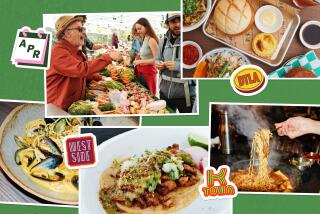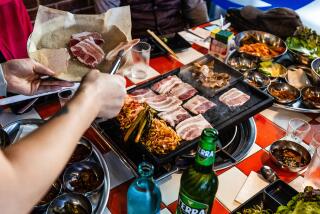Lab tests cast doubt on olive oil’s virginity
More than two-thirds of common brands of extra-virgin olive oil found in California grocery stores aren’t what they claim to be, according to a report by researchers at UC Davis.
The findings, which come as the federal government rolls out new standards aimed at cleaning up what has long been a slippery business, highlight mounting concerns over labeling accuracy for olive oil in the U.S.
“This is only a beginning, but it’s a clear warning,” said Dan Flynn, executive director of UC Davis’ Olive Center. Noting that the U.S. is the third-largest consumer of olive oil in the world, he added, “We need to be monitoring what is being sold to the public.”
The purity issue is a major concern for some consumers. In the past, some state agencies have uncovered oils labeled as 100% extra-virgin olive oil that were blended with cheaper canola, seed or nut oils — a significant health threat to people with allergies. No such mixing was found in the recent tests of products sold in California, researchers said.
Money is also at stake. Extra-virgin oil is marketed as a premium consumer product. At a Pavilions grocery store in Seal Beach, a 750-milliliter bottle of Bertolli’s extra-virgin olive oil cost $14.29, while the same-size bottle of Bertolli’s extra-light olive oil cost $7.99. (The store was not part of the report released Wednesday afternoon.)
The report underscores problems in an industry dominated by overseas importers and which has consumers slurping up more than $700 million of the stuff a year. The results were a combined effort of research conducted by scientists at UC Davis and at the Australian Oils Research Laboratory, a governmental research center accredited by the International Olive Council in Madrid, whose product standards the new U.S. Department of Agriculture rules are generally based upon.
Industry officials generally agree that the “extra-virgin” designation is proper for oil that is cold-processed to prevent degradation of aromatic compounds and has higher levels of healthful fats and antioxidants. It also has relatively low acidity levels — 0.8 grams per 100 grams or less, according to the international group.
And federal law bars a company from not disclosing on the label that it is selling a blend of oils. But a key problem in the U.S. is that the practice of labeling lower-quality olive oil as top-end — and charging a premium for it — is technically legal. The reason is simple: There are no federal rules that define what “virgin” or “extra-virgin” olive oil is. (The new USDA standards, which are voluntary, go into effect this fall.)
In March, UC Davis researchers visited retailers in Los Angeles, Sacramento and the Bay Area and bought bottles labeled as 100% extra-virgin olive oil from both domestic and imported producers. The stores included Ralphs, Safeway, Whole Foods Market and Wal-Mart.
The sampling size was relatively small. Researchers selected bottles from 14 popular import brands and five California producers. The samples were then put to a blind sensory — or taste and smell — examination by a panel of certified experts in Australia who are trained to detect flaws in such oils. The samples also were subjected to a battery of chemical tests. Some of the tests are industry standards. Others used newer approaches designed to uncover old or refined oils, said report co-author Rodney J. Mailer. UC Davis researchers reviewed their own set of blind samples.
The result: 69% of the imported oils sampled and one of the 10 California-produced samples failed to meet internationally accepted standards for extra-virgin olive oil.
“Our laboratory tests found that samples of imported olive oil labeled as ‘extra-virgin’ and sold at retail locations in California often did not meet international and U.S. standards,” the authors wrote in the report. The samples failed because of a variety of factors: heat, light exposure, age, adulteration with cheaper, refined olive oil, oils made from damaged or overripe olives, processing flaws and improper storage.
Whole Foods spokeswoman Liz Burkhart said the chain stands behind its olive oil, which sells under the 365 Everyday Value 100% Italian Extra-Virgin Olive brand.
Whole Foods, the country’s largest retailer of organic foods, uses a supplier that routinely tests the oil to “ensure it meets our requirements and the industry standards for extra-virgin olive oil,” Burkhart said.
Other retailers whose products were analyzed, including Safeway, Wal-Mart and Ralphs, declined to comment or could not be reached.
Bob Bauer, president of the North American Olive Oil Assn., said he was “somewhat skeptical” of the results. He pointed out that funding for the research — $125,000 so far — was provided by three of California’s largest olive oil producers and the California Olive Oil Council. That trade group that has been trying to grab market share from overseas competitors, whose brands dominate U.S. retail shelves. He also noted that some of the chemical tests weren’t universally accepted by the industry.
“We’ve been conducting tests on oils in the marketplace since the early 1990s, from all over the country, and we’ve never come up with results like these,” said Bauer, whose group represents most of the companies that import olive oil into the U.S.
More to Read
Eat your way across L.A.
Get our weekly Tasting Notes newsletter for reviews, news and more.
You may occasionally receive promotional content from the Los Angeles Times.






